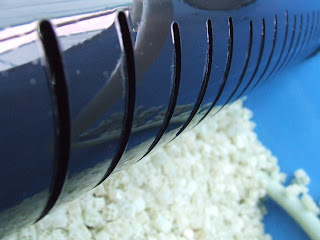Today almost felt 'routine', as though I'd finally settled into the job.
We did the usual fish check (all fine)
I did some strimming.
I took a LOT of photos -
all here in a neat album because there are far too many to fit on the blog. I'll annotate some of them so they make sense.
We did some filter cleaning. This is simple stuff, because the way they're set up allows for draining, 'boiling' of the air pump into the media - for a nice long time while you go for a cuppa, then some hosing and flushing and refilling and done! The most hazardous bit (according to Mark) is lifting the standpipe at the beginning, cos if you're not quick enough, the water shoots up your sleeve (I caught the moment it tried!)
I learned more about the colouration of koi. There are two types of black - sanke black, which tends not to extend below the lateral line, is preferably not on the head and may or may not have small black flecks in the fins; and showa black, which is all over the place (including below the lateral line) and often has nice thick stripes in the fins. Shiro utsuris have showa black, shiro bekkos have sanke black. Black on a kohaku is a shimi, and is a Bad Thing. Black is called sumi.
I had to show you Suzie - Mark's homemade fry-sorter. It has 7 suction stations and works by magic (well, not really, but he said it's a trade secret it took him a year to figure out, so he's keeping schtum)
I strimmed another patch and learned how to do it even better (apparently I was being aggressive! Moi?) and found that unwinding nettles from a strimmer is not that fun. And quite sting-y. (I was offered PPE, dear college tutors - I refused the gloves cos once again I thought I knew better. The visor came in handy again though)
I got to clean the filter screens today, having observed them being cleaned in previous days. Mark talked me through one, supervised me through another, then let me do the rest. My responsibilities are edging upwards from 'observer' status, which is a good thing. Standards being so high at Cuttlebrook, this is no small thing.
There is a right way to wire a plug. This is it.
There is also a right way to hard-wire an air pump into an air system to supply the whole tosai house. This was done after we built a pretty stand of blocks for the pump to rest on (the wood which had been used previously was vibrating in time to the pump and making rather a loud noise, so concrete was the way forward)
Finally before I left for the weekend, Mark gave me a lesson in How to Catch a Koi after I complained that my favourite was being camera-shy.
Be gentle. Really gentle. And confident, but slow and calm.
And use the net to cut off the fish's exits (they only swim forwards, as a rule, so this is reasonably easy)
The fish stays in the net, in the water
The edge of the net tips over the floating crate
So the fish can swim straight in
Hey presto! A fish, cool, calm and collected. And gorgeous.
If you have cause to lift the fish from the water, hold it with its head towards you and don't grasp it, but cradle it with your hands, allowing them to move with the fish. Mark held up the goshiki so that I could get a better photo of its scales.
Oh! Last but not least - a very cool invention: homemade bar dividers for fry - the tinies swim through, the biggies stay in and you pop them in a different pond. Different sized gaps between the bars allow for grading of different sized fish. Simple and effective (and about £100 cheaper than manufactured ones)
A great first week. Roll on Week 2.


















































